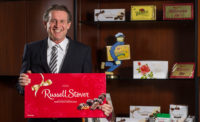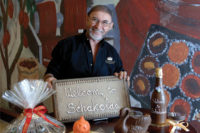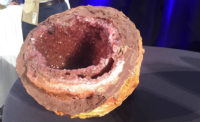Krzysztof Kotas is no stranger to hard work. Nor is he afraid to make a decision or to take a risk. And he certainly has a knack for timing. As a result, he’s created — virtually from wafer batter — the multimillion-dollar Millano Group, which now stands poised to change the chocolate landscape in the United States.
The history behind Kotas’ and the Millano Group’s success doubles as a Polish Horatio Alger novella. As a 15-year-old, he was already helping his mother make wafers in the basement of their rented home just outside of Poznan, Poland in order to help the family earn a living. Kotas was also attending culinary school at the time.
And each morning his mother would trek over to Poznan’s Main Square and sell out her wafers and cakes within an hour — the monies helping the family survive Poland’s lean economic times in the late 1970s and early 1980s.
Given the scarcity of food stuffs during that period, freshly made pastries and cakes were eagerly sought after, the Poles being known for their sweet tooth. Kotas’ lessons in culinary school soon led to the introduction of chocolate-enrobed wafers to complement the existing line of strawberry and chocolate-filled wafers.
Nonetheless, even though the business had expanded to the point of having 50 hand-operated wafer irons, demand continued to outstrip production. Kotas, thanks to an inherent talent for mechanical tinkering, managed to build his own enrobing machine from parts gleaned in flea markets.
It was at this point in time that Kotas made the first of what would be many pivotal decisions for the business: he created his own chocolate moulds from wood. Perhaps it stemmed from him viewing an early film version of Willie Wonka and the Chocolate Factory. Or perhaps it stemmed from his desire to replicate the process he saw in culinary school.
Regardless, he was both inspired and determined to start making chocolate bars, eventually constructing his own moulding line to do so. Once again, demand quickly outstripped production capacity. Given an economy where many of the goods were dispensed to households through ration cards, providing locals the opportunity to purchase real chocolate immediately proved golden, driving business growth.
The onset of the Solidarity movement, subsequently followed by the imposition of martial law and then the eventual downing of the Berlin Wall, eventually ushered in a new era for Poland and its economy, resulting in a democratically elected government and a shift toward a free enterprise system.
At this point in time, Kotas had built up his mother’s business to where the company had seven trucks and was selling its chocolate bars and wafers throughout Poznan. Dubbing the company El Millano to take advantage of the high regard that Italian goods had in the country, the 22-year-old entrepreneur was anxious to take advantage of the new political, social and commercial freedoms sweeping Poland.
No surprise then that in 1990 Kotas decided to visit the PolAgra Food Show being held at the city’s Trade Fair complex. It was an opportunity to see if he could pick up some news ideas and concepts. As Kotas explains, “The fair was our window to the world, allowing us to see things we wouldn’t normally see every day.”
Nonetheless, he had no illusions about buying anything from anyone at the fair. It was strictly “to inspect machinery and see if we could build it ourselves.”
It was at this time that the young chocolate executive found himself at the A.E. Nielsen booth, fascinated by a moulding line that cost 1 million German marks (about $562,000).
“Of course, to me, that machine was an abstraction, as if I would be buying a rocket to take me to the moon today,” Kotas says. At the time, the company was capable of producing five to 10 tons of chocolate a day. Fascinated by the line, however, Kotas found himself returning to the booth, checking on this aspect and the other of the moulding line. Again, the thought was to see if he could replicate the line himself.
Jan Hedstrøm, president of A.E. Nielsen, couldn’t help noticing the young man’s interest. In approaching him, the Danish supplier of moulding and enrobing lines asked whether he had a chocolate company. Kotas replied that he did, albeit a small one.
After several subsequent discussions, Hedstrøm asked Kotas whether he could come and visit the operation. Taken slightly aback, Kotas agreed. It was an eye-opening experience for both.
Upon seeing Kotas’ self-made moulding line, the supplier was both amazed and in awe at the ingenuity. He also recognized an opportunity for a quantum leap forward for Kotas. So he offered to sell him the equipment with a “pay me back as you grow” credit terms.
Kotas, as much as he wanted to agree, refused the offer. “I was convinced I could never pay him back; he was an honest gentleman and I really didn’t want to take advantage of him.”
Hedstrøm, however, didn’t give up. He came back to visit Kotas a second time. The same response. It was the third visit that changed everything, however. Hedstrøm told Kotas that if he couldn’t pay him back after agreeing to purchase the machine, the company would simply repossess it. One simply couldn’t walk away from such an offer. There also was one additional caveat; the business needed to be housed in a new facility.
Within seven months, Kotas had the land and a 35,000-sq.-ft. building. It didn’t take long before Kotas was able to pay off the machine, a period of eight months. He then purchased a second line, then a third, and so on. By 1995, the company was operating six moulding lines and selling its products not only throughout Poland, but to Bulgaria, the Czech Republic, Hungary and Russia.
The 35,000-sq.-ft. factory quickly underwent several expansions, rising to four floors and expanding to 120,000 sq. ft. It also became the Kotas’ family new residence, which now included three boys, Tomasz, Rafal and Bartek.
In 1995, together with a distributor in Russia, the Millano Group established a joint venture and purchased a factory in the country. Five years later, the company purchased a confectionery factory in Slupsk, Poland following a bankruptcy by a German investor.
Sales continued to grow, with the company selling products throughout Western Europe, primarily private-label items to retailers. During this entire period, Hedstrøm continued to act not only as a supplier of moulding lines, but as a business advisor and confidant.
In 1999, Kotas made another critical decision; he elected to become a bean-to-bar operation. Admitting his knowledge about cocoa processing was limited at best, the resourceful chocolate manufacturer determined to make the transition, absorbing as much knowledge as possible.
As he explains, the decision stemmed in large part to not only control ingredient costs, but to increase availability and flexibility.
“Then, like today, everything changes like a kaleidoscope,” Kotas says. “So even when you’re working with forward contracts, customers change their minds. By becoming a bean-to-bar operation, we can create the kind of chocolate we want or what our customers want when we want it.”
The process wasn’t necessarily an easy one, he recalls. “We had to throw out several tons of chocolate when I was learning. Today, it’s different. When someone asks how do you make chocolate, the answer is, ‘You just push a button.’”
It’s a button that definitely produced results. By 2006, the company committed to building an entirely new manufacturing and headquarters facility encompassing 350,000 sq. ft. and standing two stories tall. Completed in 2008, the complex features a custom-designed gravitational mixing/grinding unit that feeds four five-roll refiners, which subsequently feed four 12-ton double-conches.
Eight 35-ton holding tanks for milk and dark chocolate (6 milk and 2 dark) pump chocolate as needed to tempering units located throughout the plant. With the addition of two new moulding lines in 2014, the facility features three high-speed moulding lines as well as several specialty lines for seasonal novelties. This year, the facility is projected to turn out 55,000 tons of chocolate products.
It was during the completion of the new facility that Kotas thought it would be a good time to establish a beachhead in the world’s largest single market — the United States. Of course, who could he trust to kick start such an initiative? Well, it was Tomasz, his eldest son.
Actually, it was Tomasz who volunteered. Having studied in Switzerland and Poland, Tomasz also received a singular education under his father’s watchful eye.
“I’ve worked every job in the company, from sweeping floors to fixing machines, from working in the accounting department to handling sales,” he explains. It’s a family business philosophy that Krzysztof believes is critical to managing the company, one he applies to all his sons.
The elder Kotas smiles upon being asked how he felt about Tomasz making the long-term commitment to leave Poland and establish a subsidiary in the States.
“He wanted to get away from his father so he could have someone call him ‘Boss,’” Krzysztof quips.
As with most companies entering the U.S. confectionery market, the initial step involved aligning oneself with a distributor. Upon establishing European Chocolate Ltd. as a subsidiary of the Millano Group in 2009, the company was able to post its first sales in 2010, a combination of private-label products as well as advent calendars for retailers.
The volume, nonetheless, began to grow. During the course of connecting with buyers across the United States, several approached Tomasz.
“They were urging me to sell to them direct,” he says. It was at this time that the head of the distribution company European Chocolates was working with passed away.
Fate had intervened and it seemed appropriate for the U.S. subsidiary to begin working with retailers directly in providing them with a broad range of private-label products — similar to what the Millano Group was doing in Europe.
And although that effort proved successful, the confectionery private-label market in the United States, even for chocolate, was much smaller than in Europe. Whereby private-label sales account for more than half of all confectionery sales in Europe, the percentage in the United States has only grown to 3 percent, Tomasz explains.
Recognizing that the potential for growth — given the Millano Group’s capabilities — remained high, he began to explore the possibilities for launching a branded line in the United States. After meeting and then hiring Chris Mattina as senior v.p. and general manager, Tomasz felt confident he had added the right combination of experience and enthusiasm to set the initiative in motion.
Mattina, who’s worked for Lindt USA, Godiva, Storck and Unreal, was more than familiar with the premium chocolate market as well as challenges involved with spearheading a completely new brand with retailers.
Both Mattina and Tomasz were convinced that there was an opportunity for a company such as European Chocolate to introduce a “unique proposition” within the U.S. chocolate category, one that bridged the gap between premium chocolate and mainstream chocolate.
“Our thought was to go after the single mom with four kids who’s heard about the benefits of dark chocolate, but who can’t afford premium brands,” Mattina says. At the same time, neither Mattina nor Tomasz wanted to pursue this strategy without some kind of validation.
“We went to a personal contact at Mintel to see if there was a market for an affordable chocolate product that was GMO-free, contained no trans fat and delivered a premium experience,” he explains. “Everything they showed us said yes.”
Taking advantage of a brand that Krzysztof had acquired earlier in the Millano Group’s history, Baron, the two set out to revise the packaging and product formulation to reflect a premium product. In February 2013 at an ECRM Everyday Confections seminar in New Orleans, Tomasz and Mattina brought 10 sets of mockups, and eating samples to test the concept before buyers.
“We had five bags of truffles, which included milk chocolate, dark chocolate, lava cake, strawberry cheese cake and caramel brownie flavors” says Mattina. “The keys were to deliver indulgent as well as unique flavors.
“With regards to tablets, we focused on providing known favorites, such as milk chocolate, 70% dark chocolate, dark raspberry, orange almond, milk chocolate with sea salt caramel and milk chocolate almond,” he adds.
The response proved overwhelmingly positive, with buyers asking for products immediately. Luckily, the two had the support of the Millano Group’s bean-to-bar operation to lean on. Although they couldn’t guarantee the line for 2013, Baron Chocolatier would definitely be on the shelf in 2014.
The Baron line first started appearing in the New York, in hipster areas such as the Bronx, Queens and Brooklyn.
“We were even getting an ethnic class of trade at the bodegas,” Mattina adds.
The company was also generating a buzz in social media, with millennials becoming “early adaptors” of the chocolates and passing on their discoveries to friends. Shortly thereafter, chains such as Meijer’s and Menard’s took on the Baron line in the Midwest.
Within 18 months, the Baron Chocolatier chocolates went from zero sales to $15 million and distribution in 80,000 stores in the U.S.,and Canada.
Such rapid success, however, hasn’t stopped Tomasz and Mattina from continuing to introduce new innovations — everything from a new 100-g slim bar to limited-edition summer truffle flavors. The surge in sales also prompted a move to a larger warehousing facility encompassing 40,000 sq. ft.
That location, however, has already reached its limits. As a result, the company has begun looking for a new location, in several states, that would include a warehouse in the 60,000 to 100,000 sq. ft. range. Ironically, the Millano Group is also facing a similar problem.
There, however, the company has already committed to a new 200,000-sq.-ft. warehouse that will be built next year directly across from the headquarters facility. Currently, the company occupies a 150,000-sq.-ft. building that is several kilometers away from the production plant.
Tomasz points out that the new space in the United States will allow the company to receive more items in bulk and then subsequently repack several items for customers. It will also allow more efficient buildups of shippers, which have proved very popular amongst a broad range of retailers.
The 30-year-old president points to a tabletop shipper that holds one of the company’s newest launches, the 50-gram version of its chocolate bar line. The eight flavors, which include the recently added toffee crunch variety, provide retailers with an ideal impulse purchase ($1) at the counter.
As Mattina notes, “We’re the only manufacturer offering 50-g. bars in the category, this offers a critical trial offering for the brand-affordable premium.”
European Chocolates is also the only manufacturer offering premium chocolate-covered gummi bears, an item that’s proven particularly addictive to consumers after trial.
The gummi bears are produced in the Millano Group’s Slupsk factory, which operates three starch mogul lines. Using a proprietary recipe developed by Krzysztof that enables the gummi surface to accept chocolate, the gummies retain their definition and detail. “In keeping with our core principles of a “Heathier Option” we formulated the gummies with fruit juice, no artificial colors or flavors, and no beef gelatin to insure our kosher certification” Mattina adds.
“You can actually see the bear, and not a glob,” says Tomasz. “The gummi fruit flavors and milk chocolate do really work well together.”
Two of the nation’s largest retailers agree. The products — chocolate-covered gummi bears and gummi worms — will be distributed by a mass merchandiser and Costco this winter.
But the innovation doesn’t stop there. This past summer, the company launched a limited-edition summer truffles line featuring milk chocolate with mango crème, lime crème, papaya crème and orange cream fillings.
“We found that most chocolate companies don’t pay attention to the consumer during the summer time, chocolate becomes irrelevant” Mattina says. “We think that’s a lost opportunity. Hence, the launch of the company’s “summer” flavors, which he says retailers welcomed.”
“It was a great success,” echoes Tomasz.
This fall, the truffles line will also feature two new flavors, milk chocolate in a pistachio crème filling and dark chocolate with toasted coconut crème filling. Retailers will also have the chance to capture grab ‘n go consumers with the company’s 1.06-oz mini milk chocolate offering, three truffles for a dollar.
Tomasz and Mattina are extremely proud of the strides the company has made in such a short time. The latest Nielsen data for the 52 weeks ending Aug. 1, 2015, shows European Chocolate increased sales by 45 percent. It also ranks 89th out of 1,004 chocolate manufacturers.
Both executives recognize that the increases are based on small bases and that there’s plenty of additional ground to cover. Nonetheless, the goal remains to double sales each year. Mattina expects the company to reach $100 million within three to five years.
If that happens, Baron will be in the company of kings.
At-a-Glance: The Millano Group
Headquarters: Poznan, Poland
Sales: $200 to $400 million range (Candy Industry Magazine estimate)
Employees: 1,500
Sales Breakout: EU – 70%; Poland – 20%; Other (North America) – 10%
U.S. Subsidiary: European Chocolate Ltd.
Headquarters: Vernon Hills, Ill.
Management: Tomasz Kotas, president; Chris Mattina, senior v.p. and general mgr.
Brand: Excellent Baron Chocolatier

















































































